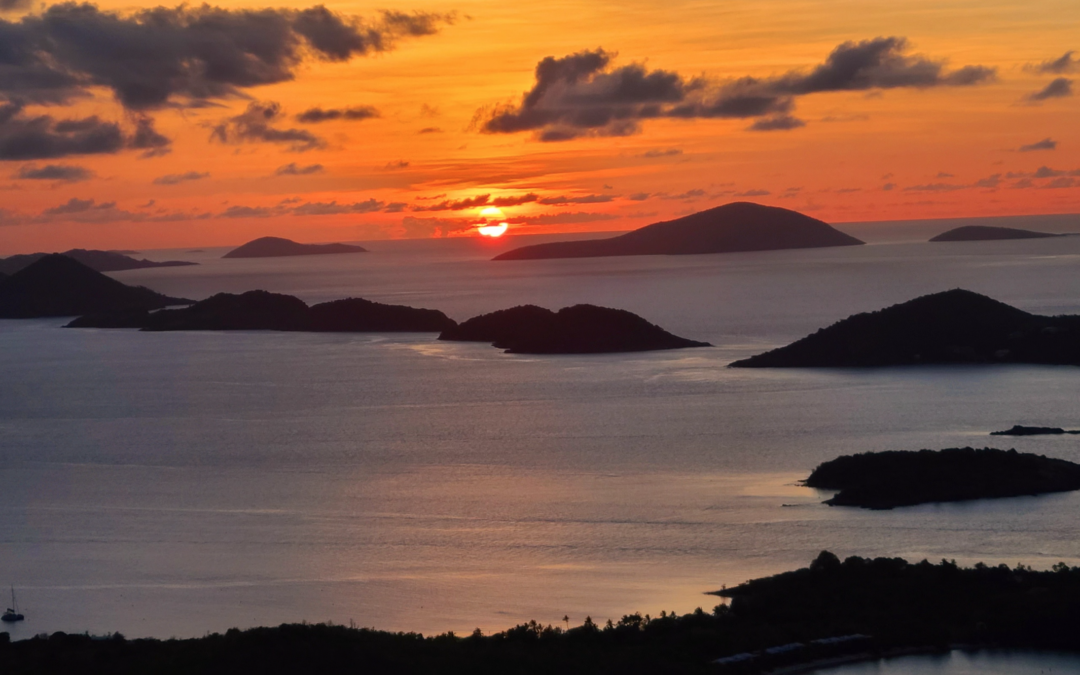Table of Contents
When it comes to breathtaking natural beauty, St. John in the U.S. Virgin Islands is hard to beat. While the whole island is a paradise, there is one daily spectacle that stands out among the rest – the St. John sunsets. Each evening, as the sun begins its descent, the sky lights up with a dazzling array of colors, creating a masterpiece that captivates residents and visitors alike.
Best Location to Watch the Sunset in St. John
Discover the epitome of serene yet lively sunset viewing at the iconic Windmill Bar in St. John. Nestled amidst the enchanting natural beauty, this rustic-chic bar offers an unobstructed vista of the sun tenderly dipping below the shimmering horizon, casting a warm, golden glow over the tranquil Caribbean waters.
As day transitions into night, and the sky paints itself with a palette of vibrant hues – fiery reds, soft pinks, and deep purples, the Windmill Bar transforms into a lively evening retreat. The ambient lighting flickers softly against the night sky, while the gentle strum of island music adds rhythm to the cool evening breeze, creating a perfect blend of natural beauty and local St. John charm.
The Windmill Bar, with its rustic ambiance, amiable service, and spectacular sunset views, embodies the heart and soul of St. John, making it a must-visit destination for anyone yearning to experience the island’s picturesque sunsets amidst a vibrant, welcoming atmosphere.
St. John also offers numerous vantage points to witness its glorious sunsets. Whether you prefer the sandy shores or embarking on a hiking adventure, there is a spot for everyone to appreciate the beauty of a St. John sunset.
The Magic of St. John Sunsets
The sunsets in St. John are truly magical, leaving spectators in awe of nature’s grandeur. But what exactly makes these sunsets so special? Understanding the science behind the colors and the role of weather can help us appreciate the beauty of these evening displays even more.
Understanding the Science Behind the Colors
When sunlight passes through the Earth’s atmosphere, it interacts with molecules and particles, scattering the shorter-wavelength colors like blue and violet. This scattering effect creates the stunning reds, oranges, and pinks that we associate with sunsets.
Did you know that the specific composition of the atmosphere can also influence the colors we see during a sunset? The sunsets in St. John benefit from the island’s unique atmospheric conditions. The combination of clean air and minimal pollution allows for a more vibrant and vivid display of colors. As the sunlight travels through the pristine air, it encounters fewer particles that could scatter or absorb the light, resulting in a more intense and breathtaking sunset.
Furthermore, the angle at which the sunlight enters the atmosphere during sunset plays a role in the color palette. As the sun gets lower in the sky, its light has to pass through a larger portion of the atmosphere, increasing the scattering effect. This phenomenon is known as Rayleigh scattering, named after the British physicist Lord Rayleigh who first explained it in the 19th century. The longer path the sunlight takes through the atmosphere during sunset enhances the warm tones, creating a mesmerizing display of reds, oranges, and pinks.
The Role of Weather in Sunset Beauty
Weather conditions play a crucial role in determining the beauty of a St. John sunset. The presence of high-level clouds, such as cirrus clouds, can add depth and texture to the sky, creating a more dynamic and breathtaking sunset.
But it’s not just the clouds that contribute to the spectacle. The overall weather patterns and atmospheric conditions can also influence the sunset’s appearance. For instance, the humidity levels in the air can affect the clarity and saturation of the colors. On a dry and clear evening, the sunset colors may appear more vibrant and distinct, while a humid atmosphere can create a softer and more diffused palette.
Interestingly, atmospheric pollutants, such as dust and smoke particles, can also enhance the sunset colors. While pollution is undesirable in general, these particles can scatter the sunlight in unique ways, intensifying the reds and oranges in the sky. During the summer and fall seasons, dust from the Sahara Desert creates the most stunning displays
As the sun sets over the horizon, the interplay between the atmospheric conditions, the angle of the sunlight, and the presence of clouds creates an ever-changing masterpiece in the sky. Each St. John sunset is a unique and awe-inspiring experience, showcasing the beauty and wonder of nature.
The Cultural Significance of Sunsets in St. John
For the residents of St. John, sunsets hold a special place in their hearts. In addition to being a natural marvel, sunsets have become embedded in the island’s culture, inspiring art, literature, and local beliefs.
Sunsets in Local Art and Literature
Local artists have long been captivated by the beauty of St. John sunsets. From vibrant paintings to intricate sculptures, many talented individuals have sought to capture the essence of these awe-inspiring displays.
Traditional Beliefs and Legends About Sunsets
Sunsets have also held deep significance in the traditional beliefs of St. John. According to local legends, the setting sun is believed to usher in good luck and ward off evil spirits. Many residents still observe these beliefs and find comfort in the sunset’s symbolic meaning.
St. John residents have a deep respect for nature, and the sunsets act as a reminder of the island’s beauty and interconnectedness of all living things.
Capturing St. John’s Sunsets: Photography Tips
Whether you are a professional photographer or a casual snap-happy traveler, capturing the beauty of St. John sunsets can be an incredibly rewarding experience. Here are some tips to help you take stunning sunset shots:
Best Camera Settings for Sunset Photography
- Use a tripod to ensure stability and avoid blurry images.
- Set your camera to aperture priority mode (A or Av) to control depth of field.
- Choose a low ISO setting to reduce noise in your photos.
- Experiment with different white balance settings to capture the true colors of the sunset.
Composition Techniques for Stunning Sunset Shots
- Frame your shot with interesting elements, such as silhouettes of palm trees or rocks, to add foreground interest.
- Experiment with different angles and perspectives to find the most captivating composition.
- Include the surrounding environment, such as the ocean or mountains, to give a sense of place.
- Use leading lines, such as a gently curving beach or a pier, to guide the viewer’s eye towards the sunset.
Planning Your Visit to St. John for Sunset Viewing
Best Times of Year for Sunset Viewing
St. John experiences peak sunset beauty during the months of December to April when the island’s weather is generally dry and less prone to cloud cover. During this time, you can expect clear skies and vibrant colors that will leave you breathless.
However, even outside of these months, St. John still offers breathtaking sunsets. The island’s tropical climate ensures that there is always a chance to witness moments of natural beauty.
In conclusion, St. John sunsets are a testament to the incredible beauty of our planet. From the science behind the colors to the cultural significance they hold, these daily masterpieces are a must-see for anyone visiting or living on the island. So, find your perfect spot, whether you are at the notorious Windmill Bar, a sandy beach, or a scenic hiking trail, and be prepared to be mesmerized by the sheer magnificence of a St. John sunset.

